The Dark Knight's Journey Part 1
By Josh Dean
July 21, 2012 - 19:05
Studios: Warner Brothers
Writer(s): Christopher Nolan
Starring: Christian Bale, Tom Hardy
Directed by: Christopher Nolan
Rating: PG13 (Parents Strongly Cautioned)
Christopher Nolan’s Dark Knight Trilogy
SPOILERS AHOY FOR ALL THREE MOVIES!
Batman has been steadily present in popular culture since his debut in Detective Comics #27 in 1939. Besides the comic books from whence he sprang, we’ve seen movies, serials, television programs, cartoons, live stage shows, video games and novels. Others far more talented than I have written about the enduring appeal of the Dark Knight Detective and the fact that the core concept is malleable to such a wide variety of interpretations. After becoming a kind of grotesque parody of itself at the box office, the Batman franchise had run out of steam with 1997’s Batman and Robin. Taking a bit of a chance, Warner Brothers handed the keys to the franchise to a relatively low key indie director named Christopher Nolan. Nolan, in turn, produced one of the most successful trilogies of all time (if the most recent film holds up in regards to popularity).
Mark Waid, speaking as a successful comic book writer, said that good superhero stories are about something. That is to say, as much as we love watching people in costumes duke it out on the big screen, we need something a little more substantive. Following the rules of good cinema, Nolan and his co-writers (comic writer David Goyer and Nolan’s brother Jonathan, who also helped write the excellent Prestige) have succeeded in making each movie a journey unto itself. The minor miracle they have pulled off is also making the trilogy a journey as well. I would argue that each movie works on its own merits; however, they all strengthen each other as a whole.
There are a few arcs I wish to follow throughout the three films, three questions I wish to answer. How does Bruce Wayne/Batman change throughout the three movies? How does Gotham change throughout the three movies? How does evil change throughout the three movies?
Part 1 BATMAN
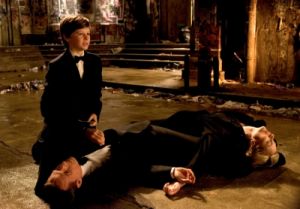 |
Rachel is the person who convinces Bruce that Joe Chill was the symptom, not the disease. Economically, Gotham is in the dumps and that breeds crime. Oddly, Bruce still doesn’t place his efforts in the right direction. His parents fought against the economic downturn with their charitable donations and civic improvement projects. Bruce sees organized crime as a sort of parasite that drains the city while corrupting it. When I discuss the changing face of evil in Gotham we will look a little closer at Carmine Falcone and Salvatore Maroni’s empire. For now, accept that Bruce is still aimed at fighting the symptoms. Considering his doctor father, Batman Begins is like a long episode of House where the caped crusader finally figures out where true evil lies.
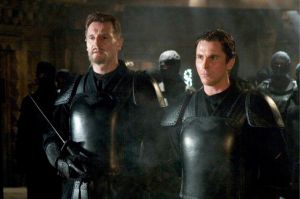 |
The Joker says a very telling thing in The Dark Knight. He says, “You’re not one of them, even if you wish you were” implying that Batman, deep down, wants to be a police officer. He wants to be a legitimate force for justice working within the confines of the law. Although his parents taught him compassion, I believe it is his love for Rachel that drives his belief that the system can be saved. He has felt the kindness provided by young Officer Gordon after his parents were killed. He knows there are good people in the system. I don’t think Bruce realizes the dual power represented by his Batman persona until Dark Knight Rises. He is counting on fighting crime with a fearsome, legendary alter-ego. He doesn’t see that he can inspire and lead the way to a better Gotham with that same persona. He actually denies the most potent aspect of his creation until the last act of Dark Knight Rises. But I get ahead of myself.
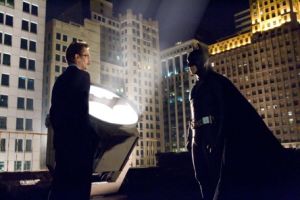 |
The biggest problem, for me as a Batman fan, with Batman Begins was the final confrontation with Ra’s Al Ghul. Having made the mistake of sparing Ra’s his life at the beginning; Batman decides to let him die as the elevated train they are in crashes and explodes under Wayne Tower. Bruce seems to be going against his principles of compassion and the rule of law in order to deliver a pithy bon mot as his enemy dies. The whole idea of Batman (as made plain in The Dark Knight) is that he lives by certain rules and doesn’t deviate from them. In fact, that he doesn’t allow the Joker to die at the end of Dark Knight seems to enforce this idea. In the end, all I could figure was that there is no justice waiting for Ra’s in Gotham since he has “infiltrated all levels of power.” Ironically, this was the lesson Ra’s was trying to teach Bruce all through the beginning of the movie, when the law fails justice must be served.
Realistically, and in retrospect, Bruce did not yet have the allies and friends in place who could bring Ra’s to justice. Therefore, Ra’s had to die. It seems pretty pragmatic for Batman, who does not yet have the luxury of idealism. If there is an arc to Batman throughout the three movies, it is that, as his legend grows, his ability to live up to his ideals increases. Batman has to kill the legendary Ra’s Al Ghul to become the legendary Batman. Somewhere between Batman Begins and The Dark Knight, criminals begin catching on that he won’t kill them. Therefore, it is time to change the legend.
In The Dark Knight, Batman has now reached the status of symbol. He is inspiring average joes on the street to dress like him and attack criminals. The opening fight in The Dark Knight is a perfect storm of all the problems in Gotham. Batman must face his imitators, the last vestiges of organized crime and the rising tide of freak villains (Scarecrow) who are looking to combat Batman using his own tactics. Unfortunately, Batman has no control over his message. His followers rely on guns and homemade armor which places them in danger. Batman wants to inspire people to take back the street but he wants to do it through the law.
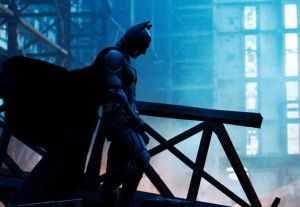 |
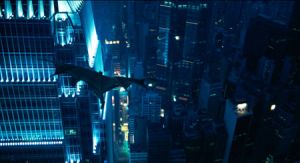 |
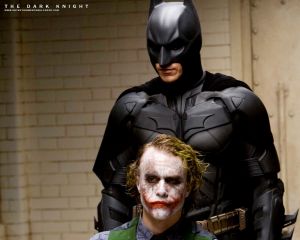 |
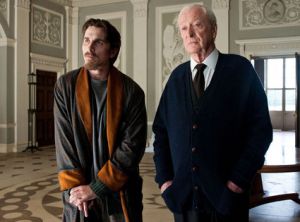 |
Only through multiple prods and pushes does Bruce decide to reclaim his mantle as Batman. The name has been the source of urban legends and his symbol is one school children still believe in. The symbol was potent and has only increased in potency through time. Having lost his fear back in Begins, Bruce is confident and cocky that he can face any challenge and come out on top. Of course, he also has a bit of a death wish. With nothing to look forward to, no Rachel waiting, he just wants to commit a heroic sacrifice. He knows battling Bane might destroy him but, he seems ok with that idea. This will be the final step of the legend, to martyr oneself as they claimed Dent did to fight evil.
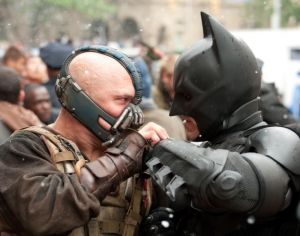 |
The old men in the jail claim he needs to embrace his fear. He has to find it again. His lack of fear made him a legend but Gotham needs a heroic man to regain its humanity. No one has yet pointed out that Batman makes his first day time appearance in this movie. Without the shadows making him a horror-movie spook, he is a man in some weird armor. He inspires and leads the police army in the final battle with Bane’s minions. Bruce finally gets to be a force of order, an agent of the status quo. Of course, order is restored to Gotham but we never quite find out if it recovers economically. Perhaps that is why someone else is forced to take the mantle of the bat, so long as the inequalities that create a criminal class exist, so too will crime. This seems to be the ultimate failure of Bruce Wayne, he squandered his resources on a war against crime when it seems a war against poverty would have been the smarter battle.
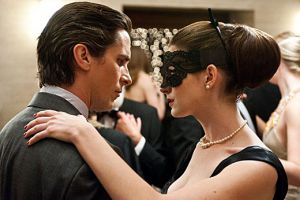 |
Next time I will discuss how Gotham grows and changes over the course of the films (besides turning from Chicago into New York) and how the villains of the Bat-verse reflect and add to Batman’s own journey.
Related Articles:
Dark Knight III: The Master Race #9 comics review
Dark Knight III: The Master Race #8 comics review
Dark Knight III: The Master Race #7 comics review
Dark Knight III: The Master Race #6 comics review
Missed Call #2: The Dark Knight vs. The Dark Knight
Batman - The Dark Knight Rises Miracle Action Figure
Batman The Dark Knight Returns Part 2
Batman The Dark Knight Returns Part 1
The Dark Knight Returns Part 2 on DVD/Blu-Ray Today
The Binquirer, August 9 Edition: New Legends of the Dark Knight lineups, Ben Affleck and Justice League, and much more!
